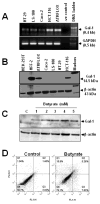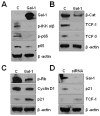Galectin-1 is silenced by promoter hypermethylation and its re-expression induces apoptosis in human colorectal cancer cells
- PMID: 21122983
- PMCID: PMC3023883
- DOI: 10.1016/j.canlet.2010.10.027
Galectin-1 is silenced by promoter hypermethylation and its re-expression induces apoptosis in human colorectal cancer cells
Abstract
Galectin-1 (gal-1) is an important molecule secreted by many tumors, which induces apoptosis in activated T-cells and promotes tumor angiogenesis, both of which phenomena facilitate successful establishment of tumor in the body. However, little is known about the function of intracellular gal-1 or its transcriptional regulation in colorectal cancer (CRC). Here, we demonstrate that gal-1 expression is epigenetically regulated in CRC through promoter hypermethylation. Intracellular gal-1 induces cell cycle arrest and apoptosis in CRC cells with concomitant down-regulation of Wnt and NF-κB signaling pathways. Together, these data suggested that gal-1 silencing imparts CRC with the ability to proliferate and escape apoptosis.
Copyright © 2010 Elsevier Ireland Ltd. All rights reserved.
Conflict of interest statement
Conflict of interest: None.
Figures






Similar articles
-
Analyzing epigenetic control of galectin expression indicates silencing of galectin-12 by promoter methylation in colorectal cancer.IUBMB Life. 2017 Dec;69(12):962-970. doi: 10.1002/iub.1690. Epub 2017 Nov 3. IUBMB Life. 2017. PMID: 29098769
-
Galectin-4 functions as a tumor suppressor of human colorectal cancer.Int J Cancer. 2011 Aug 15;129(4):799-809. doi: 10.1002/ijc.25750. Epub 2010 Dec 9. Int J Cancer. 2011. PMID: 21064109 Free PMC article.
-
ROR2 is epigenetically inactivated in the early stages of colorectal neoplasia and is associated with proliferation and migration.BMC Cancer. 2016 Jul 20;16:508. doi: 10.1186/s12885-016-2576-7. BMC Cancer. 2016. PMID: 27440078 Free PMC article.
-
Galectin-1 fosters an immunosuppressive microenvironment in colorectal cancer by reprogramming CD8+ regulatory T cells.Proc Natl Acad Sci U S A. 2021 May 25;118(21):e2102950118. doi: 10.1073/pnas.2102950118. Proc Natl Acad Sci U S A. 2021. PMID: 34006646 Free PMC article.
-
Down-regulation of TCF21 by hypermethylation induces cell proliferation, migration and invasion in colorectal cancer.Biochem Biophys Res Commun. 2016 Jan 15;469(3):430-6. doi: 10.1016/j.bbrc.2015.09.109. Epub 2015 Dec 17. Biochem Biophys Res Commun. 2016. PMID: 26435499
Cited by
-
Pancreatic satellite cells derived galectin-1 increase the progression and less survival of pancreatic ductal adenocarcinoma.PLoS One. 2014 Mar 4;9(3):e90476. doi: 10.1371/journal.pone.0090476. eCollection 2014. PLoS One. 2014. PMID: 24595374 Free PMC article.
-
A novel radioresistant mechanism of galectin-1 mediated by H-Ras-dependent pathways in cervical cancer cells.Cell Death Dis. 2012 Jan 12;3(1):e251. doi: 10.1038/cddis.2011.120. Cell Death Dis. 2012. PMID: 22237208 Free PMC article.
-
Signatures of co-deregulated genes and their transcriptional regulators in colorectal cancer.NPJ Syst Biol Appl. 2020 Jul 31;6(1):23. doi: 10.1038/s41540-020-00144-8. NPJ Syst Biol Appl. 2020. PMID: 32737302 Free PMC article.
-
CX3CL1 promotes cell sensitivity to ferroptosis and is associated with the tumor microenvironment in clear cell renal cell carcinoma.BMC Cancer. 2022 Nov 17;22(1):1184. doi: 10.1186/s12885-022-10302-2. BMC Cancer. 2022. PMID: 36397015 Free PMC article.
-
Critical appraisal of epigenetic regulation of galectins in cancer.Int J Clin Oncol. 2022 Jan;27(1):35-44. doi: 10.1007/s10147-021-02048-x. Epub 2021 Oct 15. Int J Clin Oncol. 2022. PMID: 34652614 Review.
References
-
- Rustgi AK. Molecular genetics and colorectal cancer. Gastroenterology. 1993;104:1223–5. - PubMed
-
- Issa JP. The epigenetics of colorectal cancer. Ann N Y Acad Sci. 2000;910:140–53. discussion 153–5. - PubMed
-
- Shen L, Issa JP. Epigenetics in colorectal cancer. Curr Opin Gastroenterol. 2002;18:68–73. - PubMed
-
- Liu FT, Rabinovich GA. Galectins as modulators of tumour progression. Nat Rev Cancer. 2005;5:29–41. - PubMed
Publication types
MeSH terms
Substances
Grants and funding
LinkOut - more resources
Full Text Sources
Other Literature Sources
Medical
Research Materials
Miscellaneous

